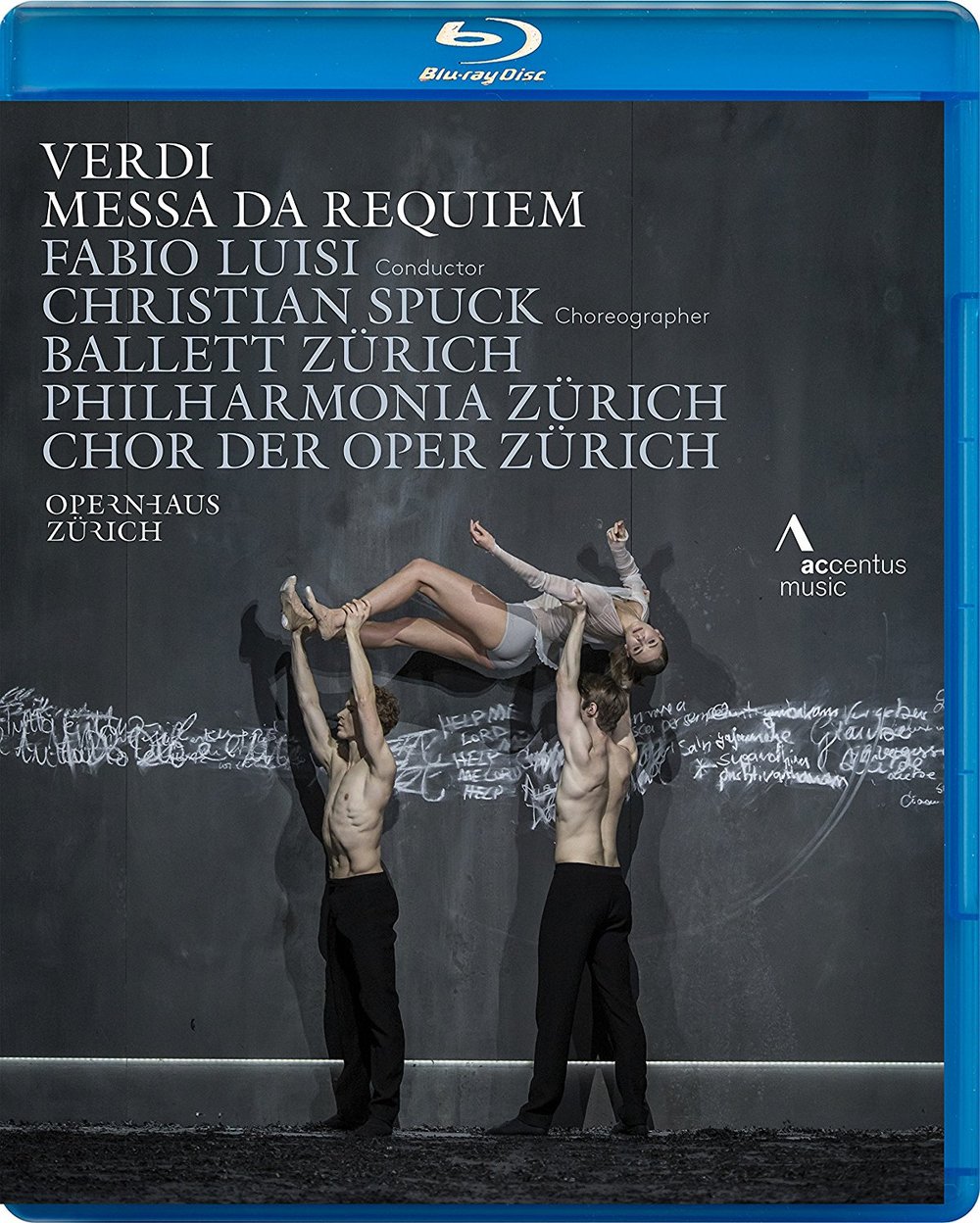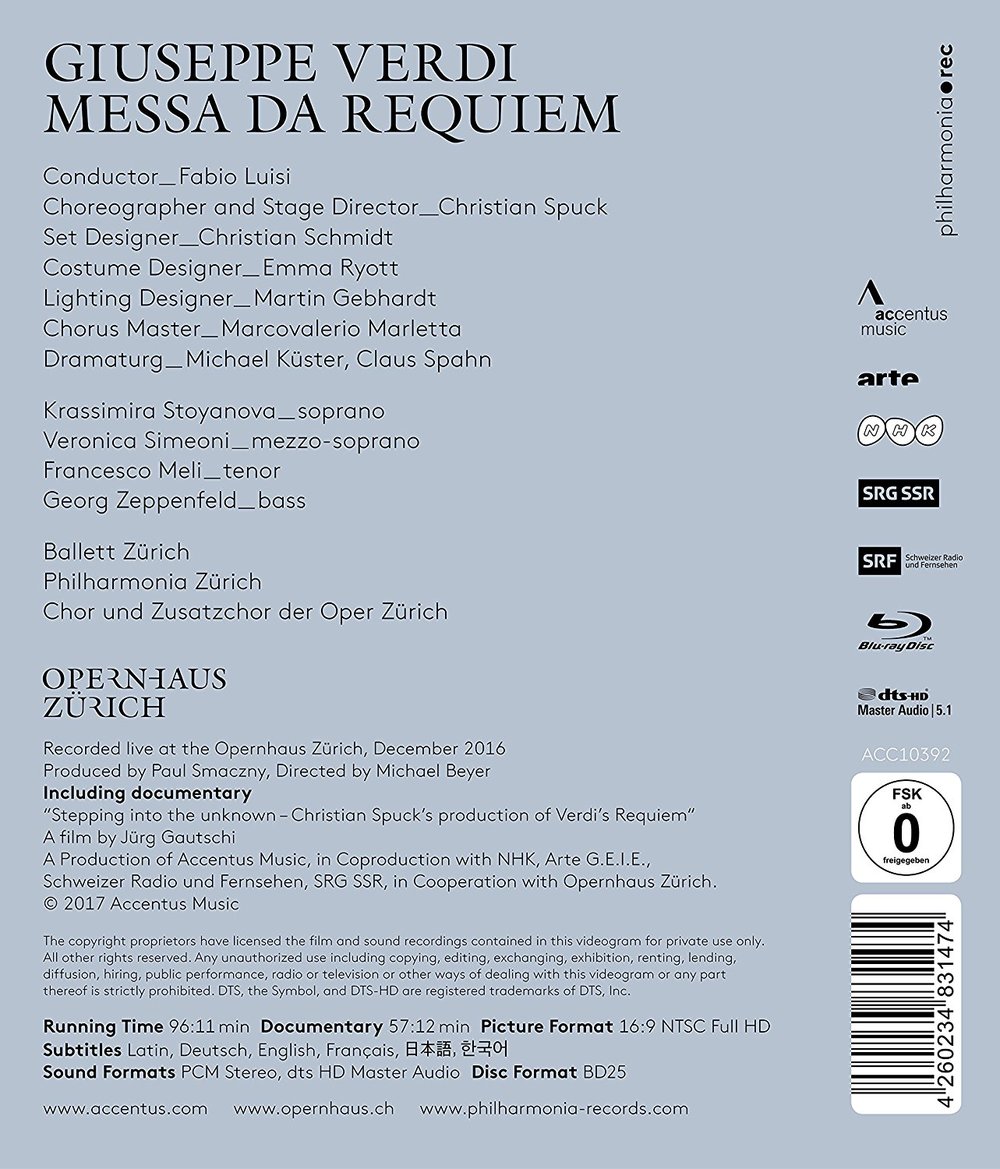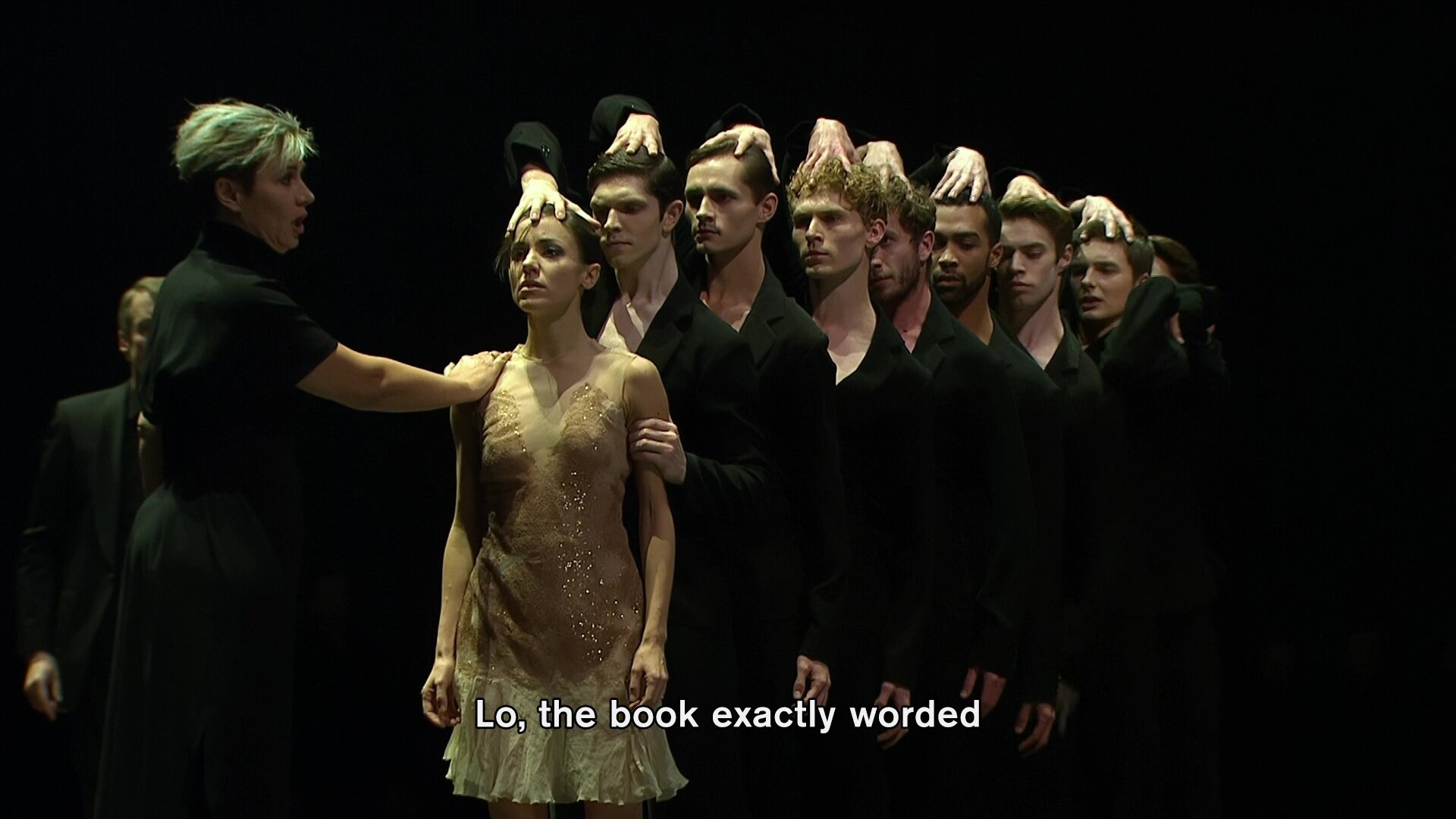

Verdi Messa da Requiem ballet and concert. Recorded 2016 at the Opernhaus Zürich. Choreography and stage direction by Christian Spuck. Fabio Luisi conducts the Philharmonia Zürich, the Chor, und Zusatzchor (Supplementary Choir) of the Zürich Opera (Chorus Master Marcovalerio Marletta). Soloists are Krassimira Soyanova (soprano), Veronica Simeoni (mezzo-soprano), Francesco Meli (tenor), and Georg Zeppenfeld (bass). Star dancers are Yen Han, Alexander Jones, Anna Khamzina, Matthew Knight, William Moore, Filipe Portugal, Manuel Renard, Giulia Tonelli, and Katja Wünsche supported by corps dancers Nozomi Iijima, Tars Vandebeek, Francesca Dell’Aria, Jesse Fraser, Michelle Willems, Mark Geilings, Wei Chen, Andrei Cozlac, Jan Casier, Constanza Perotta Altube, Cristian Alex Assis, Irmina Kopaczynska, Danien Mulligan, Galina Mihaylova, Christopher Parker, Alba Sempere Torres, Dmitry Khamzin, Elizabeth Wisenberg, Dominik Slavkovsky, Mélanie Borel, Pornpim Karchai, Chinatsu Sugishima, Meiri Maeda, and Benoît Favre. Set design by Christian Schmidt; costume design by Emma Ryott; lighting design by Martin Gebhardt; dramaturgy by Michael Küster and Claus Spahn. There is also an excellent documentary on this disc called Stepping into the unknown—Christian Spuck's production of Verdi's Requiem. Ballet directed for TV by Michael Beyer; produced by Paul Smaczny. Sung in Latin. Released 2017, disc has 5.1 dts-HD Master Audio sound. Grade: A
Verdi gets his “operatic” Mass produced here as grand theater with the introduction of 33 dancers performing modern abstract ballet in soft shoes. You can’t perform this music in churches because you can’t play the biggest bass drum in the country in a sanctuary. You can’t make it into an opera because the libretto has no story. But adding dancers (especially all those beautiful women in skimpies) adds a dramatic flair that Joe Green probably never could have dreamed of. This is no update—it’s modern ballet using Verdi’s music as a spring board.
To preempt any thoughts that he might be trying to sensationalize the Mass, choreographer Spuck cast his almost completely bare stage into darkness broken only by lonesome spots, temporary portable lanterns, and an occasional thin light band on the bottom of the rear wall. But within this purgatorial gloom everything is mobile. The soloist singers are, of course, all opera stars and used to moving about the stage and acting as they sing. The double-chorus gets a workout unlike anything they have ever experienced before singing any mass. The dancers have been coached in 16 tableaux with a huge variety of forces, formations, and steps. But the overarching theme is always the vulnerability of the individual in the face of death.
Our first view is from the initial Requiem and Kyrie. 3 women are separated from each other immersed in grief. The huge chorus, singing softly, is almost imperceptible in the darkness:
The Zürich ballet is a small, democratically-oriented company, and this libretto has no roles. The dancers aren’t even named in the keepcase materials, but they are credited in the video curtain calls. Above, creeping along the rear wall is Giulia Tonelli. Below is Giulia in a near shot writhing in agony at whatever she has just seen or experienced. As explained in Spuck’s documentary, this is no attempt to depict the medieval concepts of purgatory, judgement day, torment in hell, etc. The themes explored here are universal: fear of death, despair, remorse for sins, contrition, redemption, and salvation:
The next two screenshots below are also from the Requiem and Kyrie. The first shot shows a smart formation that attempts to brighten up the proceedings a bit, and you can see some of the solo singers in the background. But the atmosphere of doom is restored with the close-up of the beautiful young woman lying prostrate and helpless. (You might notice a rectangular hole in the stage. At the opening, there is some dry shrubbery on stage as a prop. The shrubbery is soon retracted and the hole closes. But you don’t t see any of this in the video except the hole.)
When the big drum announces Judgement Day, William Moore gives us his solo rendition of torment of the damned soul. The only physical sign of hell is the floor covered in black ashes:
And Giulia finds there is no place for any of the sinners to hide:
Where there is any light on the stage, the camera goes for it. Below a closeup of Giulia swept up in the Tuba mirum:
In the Liber scriptus Giulia learns her sins are recorded in an exhaustive deposition taken by God. On the left is mezzo-soprano Veronica Simeoni getting into the act:
And now below Simeoni is singing, acting, and dancing! Did her agent explain this to her ahead of time?
All the singing soloists have been praised for their voices by the print critics. All of them eventually get into the action as well. The solo singer with the greatest pure stage presence is the bass Georg Zeppenfeld looking here like, well, God’s bailiff:
The chorus moves about the stage like human lava coughed up from some kind of windstorm or volcano. The image below is from the Rex tremendae. A bunch of people seem to be standing on the shoulders of others. Probably these are dancers dressed in chorus black:
Tenor Francesco Meli performs a creepy solo from the Ingemisco tamquam reus. Female and male dancers in bare-back black evening dresses provide a grotesque backdrop:
Now we see the entire quartet together with a large and formal array of dancers in the Lachrymosa:
If this were an opera, the Lachrymosa would be the end of Act 1. Spuck creates an interlude here where everybody writes words from the libretto on the three walls of the stage. The stage clears for a few moments, and the Offertorio begins what would be Act 2. The image below is from the Sanctus. I think this is Katja Wünsche (not sure):
From the Angus Dei, a duet with Yen Han (for sure) and Filipe Portugal (I think):
From the Lux aeterna:
And finally, 3 images from the Libera me with soprano Krassimira Stoyanova dominating the singing:
A sudden change to dour green lighting has a big impact. Are the lifted bodies ascending to glory or heading in the other direction?
Deliver me:
I have seen the Verdi Requiem several times live in what were probably mediocre performances. Not being familiar with the Catholic Mass, I remember being a bit bored. But here the movements of the singers on the stage and the introduction of dancers has gotten me interested in the Verdi Requiem for the first time. The orchestra sounded splendid under Fabio Luisi, I loved the way the huge chorus was deployed as a living being, and I enjoyed the soloists. But most of all, I found the dancers kept my attention focused whereas I had had a tendency with the Requiem to start daydreaming.
Steven Jude Tietjen gave this title a warm review and a “Critic’s Choice” designation in the April 2018 Opera News (pages 53-54). Tietjen pointed out that "The singers and chorus not only perform from memory, they do so while executing their own choreography and movements alongside the entire company of Ballett Zürich . . . they're integrated into the stage picture." Tietjen goes on to say "Spuck's isn't a death mass for one person. Instead, it's an invitation to look and listen inward, to search for one's own personal rest." I agree with Tietjen, and I applaud this new title as an ambitious attempt to bring vision to the aid of classical music in a form that can be shared by people all over the world.
Now for a grade. SQ and PQ are good. I did a ballet Wonk Ballet Worksheet. I have in the past skewered Michael Beyer many times for making videos with horrendous cases of DVDitis. So I was surprised to see that the Beyer’s pace in this video is 9.8 seconds per clip. This still flunks the pace test, but it’s a big improvement for Beyer. I start with an A+, and reduce the grade to B+ for mild DVDitis. I make an adjustment up to A on account of Spuck’s courage in creating this innovative ballet title.
We have attached a complete libretto of this mass to our review you can reach with this link.
The trailer shown below is from the Zürich opera house and is extremely frantic, but it gives you a good idea about the style of the dancing. The full recording gives you plenty of time for repose and contemplation as the action unfolds:
OR




















